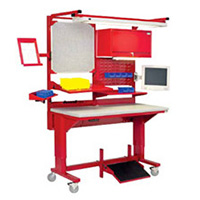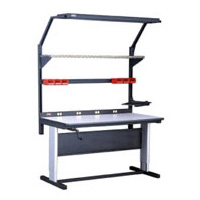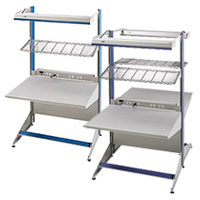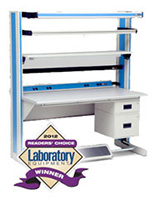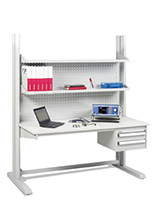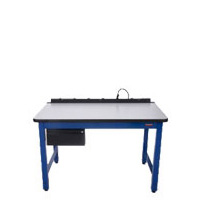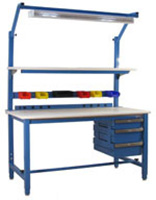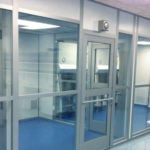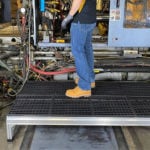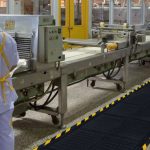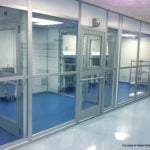One of the most common questions customers in critical manufacturing environments ask is: What type of workstation is the best investment for our current and future needs? With so many variations and unique designs available in the marketplace, the selection process can be daunting. The selection process can be daunting with so many variations and unique designs available in the marketplace Upon examining all the possibilities, the majority are not suitable for use in regulated settings. As one begins to review all available choices, many are not suitable for use in controlled environments.
Consider the Following Questions Before Choosing a Workstation:
#1. Do You Need Height Adjustment?
Do you need an ergo-adjustable or fixed workstation? Adjustability ensures that the workstation can match the proper height of your operators. This will result in enhanced safety, comfort, organization, and ultimately a more productive operation.
The ergo-adjustable workstations on the market today offer a variety of adjustment mechanisms. Many raise and lower with a manual crank, others use an electronic mechanism, and some have the intelligence to save preset heights for operators working multiple shifts electronically. Additionally, high-end models can daisy-chain multiple workstations together. This creates a larger work area for long cable assemblies or catheter manufacturing.
Not all ergo-adjustable systems are made equal. Some are built for lighter demands in an office setting. These are unsuitable for rugged environments or heavier weight loads due to production equipment or dynamic loads with moving parts.
Ergonomics and Mobility: All in One Package
One workstation design from Lista and their Align Series combines the best features of an ergo-adjustable workstation and can be made mobile on casters. Others rely on casters to only operate when the workstation is in the lowest height setting.
#2. Is Your Workstation Layout Subject To Change?
Another important question to ask yourself is whether you want your workstations to be modular or a standard 4-legged design.
While standard workstations generally follow the same 4-legged or cantilevered frame design, modular workstations come in a variety of designs. All of these designs are generally unique to that particular brand in terms of compatibility. This means that once a particular model is selected, you are committed to that designs accessories and future expansions.
#3. Is Workstation Flexibility Important To Your Operations?
Modular workstations are usually designed to be used in side-to-side and/or back-to-back layouts. Standard workstations are essentially standalone in every situation (there are some which can at least share uprights front to back). You can place a 4-legged workstation side-to-side or back-to-back, but there usually aren’t any shared components or elements physically tying them together.
The 8000 Series Workstations from Airlink, as well as designs from IAC and Treston, incorporate a column and lateral stabilizer as the foundation for further elements, thus allowing for limitless configurations. For example, 4 columns and 3 lateral stabilizers will allow you to place three worksurfaces side-by-side for a total of six worksurfaces if there are two rows back-to-back. Having shared components can lead to a lower initial investment in terms of cost per workstation. Additionally, corner worksurfaces for modular workstations allow for ‘L’ or ‘U’-shaped designs. This helps to maximize the use of space where a row of workstations would otherwise abruptly end.
#4. Do You Need Your Workstation To Breakdown Easily?
Besides the easy expansion, shared modular components can also facilitate easy breakdown or reconfiguration as your needs change. While standard workstations are just as functional as modular ones, breaking down or reconfiguring a standard workstation isn’t possible. It will always take up the same amount of space. So, you would have to order a new workstation should you need a different size.
#5. Are Uprights Important To Your Operations?
Another major benefit of modular workstations is that their design will automatically include uprights to add accessories.
Pros of Uprights:
- Columns support main worksurfaces while exteneding up several feet.
- Provides the options of shelving, overhead lighting, bin rails, tool balancer beams, or power beams.
Cons of Uprights:
- Adding uprights locks you into a specific brand.
The Bottom Line: Modular vs Standard workstations
When considering the questions of ergonomics and the need for modularity, benefits depart based on your particular need. Conveniently, a modular workstation can be adjusted in terms of the height of the work surface, but keep in mind you will bedetaching components and reattaching them to a different location on a column. Even if you won’t rearrange components every shift, it will give the user flexibility for the future.
Similarly, unless an ergo-adjustable workstation has been selected from a standard workstation design, the user is tied to that height. There are options to add leg extenders, but this is an occasional use feature by unbolting and bolting components back into place.
Modular Workstation Pros:
- Infinitely reconfigurable and expandable
- Extremely uniform and precisely engineered worksurfaces when placed side-by-side or back-to-back
- Built-in uprights
- Shared structural components can lead to reduced initial costs
- Many ‘L’ and ‘U’ and shaped layout options
- Vast array of accessories due to standardized design
- Easy break down for storage, transfer
- Some designs require no tools for assembly
Modular Workstation Cons:
- More costly per workstation if all are standalone
- Not fully adjustable with electronic or manual controls
- Custom sizes generally not available
- Some brands and designs require lengthy steps for assembly
- Fewer ‘express ship’ options
- Some designs require lengthy assembly times
Standard Workstation Pros:
- Lower initial cost (for fixed height designs)
- Ergo-adjustability options with hand cranks, and electronic motors
- Custom sizes, generally by the use of unique worksurface shapes on a standard frame
- Easy assembly for most brands and designs
- Many manufacturers who offer ‘Express Ship’ configurations
Standard Workstation Cons:
- Layout and size cannot be changed
- Uprights ordered separately, generally not part of main frame structure
- No uniform method for back-to-back or side-to-side layouts
For most applications, a standard workstation design will be more than adequate. Although, for those who wish to reap the advantages of a modular workstation, their facility will see a more versatile solution. Many design considerations have gone into the engineering of modular workstations to make them adaptable. Standard workstations meet a comfortable price point for most customers, but costs will increase if a new layout is needed. With a modular workstation design, however, many components can be reused as requirements or facility needs are updated.
Related Posts
-
Advantages of Modular Grow Room Design
Modular grow room systems improve design freedom when dividing a floor plan into separate areas for flower, clone, or veg rooms. Prefabricated structural walls, T-grid ceilings, insulated panelized roofs, and specialized cleanroom-grade panels reduce installation…
-
Why is Modular Cleanroom Design A Huge Development?
Pre-engineered fabrication consolidates scheduling with minimal disruption and fewer variables. Difficult or expensive upgrades avoid overbearing noise, construction artifacts, and minimize if not eliminate the burden on facility staff for project management.
-
FOUNDATION Modular Platforms from Wearwell Now Available
Foundation modular platforms are a wonderful addition to any workspace. Not only are they easy and cost effective but they keep your employees healthy and safe. Reaching up and down takes a toll on one’s…
-
Hog Heaven III Anti-Fatigue Mats | Modular Mats
Select interconnecting Hog Heaven tiles and end pieces for outstanding anti-fatigue qualities in dry areas. The wedge locking system allows for unlimited configuration on walkways or assembly lines for increased grip, electrical conductivity, and weld-safe…
-
GMP Cleanroom Design Standards Part 1: GMP and CGMP Manufacturing
What is GMP? What is CGMP? What are the differences between GMP and CGMP cleanrooms?
-
Cleanroom Components — Air Filtration, Design, and Other Variables
What are the key determinants of cleanroom components? Learn about different types of cleanroom filtration, wall construction, lights, temperature, humidity and more.


